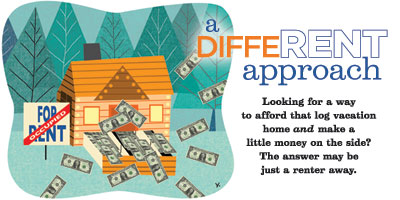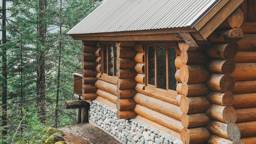
“I realized that if I could rent it out for a good portion of the year, it would bring the affordability factor home,” Christine says. Now, she owns several vacation homes—including two log homes—and is the author of How to Rent Vacation Properties by Owner. She travels widely, holding seminars to help others afford and rent out their dream homes. “I have a lot of fun with it,” Christine says. “It’s not too difficult to talk about the places I love to go.”
Like Christine, many people who dream of owning a vacation home can only afford it by opening it up to vacationers. And though Christine’s story proves it’s possible, successfully renting out your vacation home takes research and work. Not only will you need to decide whether to oversee the process yourself or hire a property management firm, to keep it rented you’ll need to set your home apart from the crowd in an increasingly competitive vacation-rental housing market.
The good news for log home devotees is that your dream cabin already comes with distinction built-in: namely its log walls. “Log homes do seem to get more attention,” says Anthony Vaarwerk, CEO of FindRentals.com, an Internet-based listing service. “There’s a certain affinity that people have for staying in a log home.”
So how do you capitalize on your log home’s appeal? Here, we’ll look at the four big questions you’ll have to ask yourself to be sure you’re renting your log vacation home the right way and getting the biggest bang for your buck.
1. How much can I make?
Whether you already own a log home or are planning to buy or build, if you’re hoping to rent it out, the first thing you’ll need to consider is how much income your property can generate. Fortunately, with a plethora of Internet listing services showcasing properties from all over the world, finding this information is easier than ever. The key is to pinpoint what similarly sized homes in your area are bringing in per week and comparing that to your mortgage payment.
“If the average rental in your area is going for $900 a week, you want to try to find a property with a $900 mortgage per month,” Christine recommends. “That way, if you rent your home out for just 12 weeks of the year, you’ve covered the mortgage payments.” If you can’t find a property whose mortgage is in line with going rates—or if your existing mortgage is higher—at least you’ll know how much you can offset the cost of ownership. After all, even if your mortgage is $1,000 a month and you can only get $500 a week, the amount it will offset can still help put a vacation home within reach.
2. Should I hire a pro or can I go it alone?
A major factor in how much you’ll be able to recoup from renting out your home comes from whether you decide to do it yourself, as Christine did, or whether you hire a property management firm to help you. Management-company fees can range from 15 to 35 percent of the income they generate. With fees for things like landscaping and upkeep tacked on, you may see as much as 50 percent of your rental revenue disappear before your very eyes. But not everyone is up to the self-management task. Given your circumstances, be it limited time or not living near your second home, hiring a property management firm may be money well spent.
“When you take into account all the phone calls, e-mails, not to mention dealing with cancellations and updating your availability calendar, renting out your home can be time consuming. Then there’s the marketing,” Anthony says. “A good property-management firm can do all of that for you, especially if you don’t live in the same area as your vacation home.” For instance, some large web sites, such as VacationSpot.com, cater to houses brokered through property management firms and can get your home maximum exposure. The key to using a firm is to do your homework first so you know you’re getting the most for those fees. “The bottom line is to try to negotiate the best price for the best level of service from the best property managers in your area,” Anthony says. You can find a property management firm near your vacation home on irem.org, the web site for the Institute of Real Estate Management.
There is money to be saved by going it alone, but it will take more effort. With a number of Internet listing services available, advertising your home is easy, though most sites charge a fee—typically $150 to $200 per year— to do so. (See “Vacation Rental Resources,” page 64.) Make sure to use a catchy headline in your ad and high-quality photographs to showcase your home.
3. Who's going to maintain it?
Once you start renting out your home, you’ll have to set up cleaning and maintenance services for it, something Christine says is one of the biggest challenges in the rental game, especially in a rural setting. “Let’s face it, most log homes aren’t in the middle of residential neighborhoods, so finding the right services can be challenging.” Her advice? Hire someone you trust, and pay them well. In the end, it’s your responsibility to make sure a reliable person is available to respond to your guests needs.
Christine does offer some basic tips to make life easier. Have two sets of sheets on hand for each bed, as well as place settings for double the number of people who will be staying there. You’ll also need rental agreements, damage deposits and even a way to accept credit card payments—something that most listing services can help you with. You can find those forms and other tips at Christine’s web site: HowToRentByOwner.com.
4. Can I write it off on my taxes?
If renting out your vacation home seems like a viable option, you’ll want to keep an eye on the tax implications. You can qualify for tax deductions on rental income, but only if you limit personal use of the home to 14 days or less per year, or 10 percent of the total time you rent it out, whichever is greater. On the other hand, if you only rent your home out for 14 days or less per year, you can keep that income tax free. You’ll have to determine which avenue has more benefits for you.
Buying a second home is a big enough gamble, let alone the idea of inviting strangers to stay there. But if you make sound decisions, the benefits definitely can outweigh the risks.
“The average vacation home, pulls in around $30,000 of rental revenue per year,” Christine says. “If you’re not renting it out, and you’re not staying there, that’s like leaving $30,000 a year on the table.” And losing out on that kind of money is a risk you can’t afford to take.
Read the full story in the September 2006 issue of Log Home Design.











